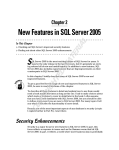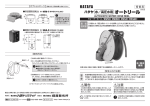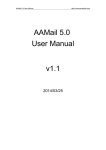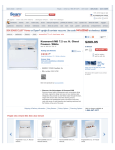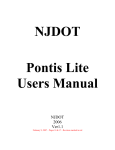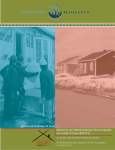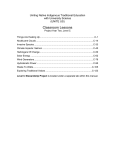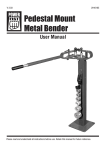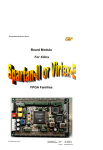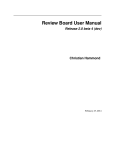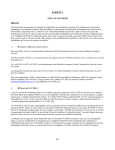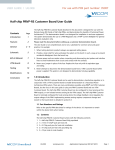Download Hi Rick, I can confirm that drilling locations have not yet been
Transcript
From: To: Cc: Subject: Date: Attachments: Walbourne, Rick [email protected] Jenica von Kuster DFO Comments on SLWB Item - S12S-002 - Husky Oil Operations Ltd. - Permafrost and Aggregate Survey Land Use Permit Application August-10-12 9:07:35 AM Mineral Exploration.pdf Hi Tony/Jenica, I've reviewed the information you provided related to the survey activities described in the subject land use permit application and concluded that DFO has no concerns. As outlined below, it is DFO's understanding that no water use will be required and that drilling locations are yet to be determined. I have attached our Mineral Exploration Operational Statement for your information. While I realize that a mineral exploration project would have a wide array of components that are outside the scope of your sampling program, there are measures within that document that should be implemented where appropriate. If you wish to discuss further, feel free to contact me at your convenience at 669-4926. Rick Rick Walbourne Habitat Biologist | Biologiste, Habitat (867) 669-4926 | facsimile/ télécopieur (867) 669-4940 Rick [email protected] Fish Habitat Management, Western Arctic Area | Gestion de l'Habitat du Poisson, Secteur de l'Arctique de l'Ouest Central and Arctic Region | Région Centrale et de l’Arctique Fisheries and Oceans Canada | 301-5204 50th Ave, Yellowknife, NT, X1A 1E2 Pêches et Océans Canada | 301-5204 50e Ave, Yellowknife,T.N.-O, X1A 1E2 Government of Canada | Gouvernement du Canada From: Jenica von Kuster [mailto:[email protected]] Sent: Thursday, August 09, 2012 1:39 PM To: Walbourne, Rick; '[email protected]' Subject: Re: Request for Comments on SLWB Item - S12S-002 - Husky Oil Operations Ltd. Permafrost and Aggregate Survey Land Use Permit Application Hi Rick, I can confirm that drilling locations have not yet been determined because the geophysical survey crew is still conducting their field survey. This heli-portable drilling program is contingent on the results of this field survey. Correct, there will be no water use for the conduct of this program. Regards, Jenica Sent from my BlackBerry From: Walbourne, Rick [mailto:[email protected]] Sent: Thursday, August 09, 2012 01:33 PM To: [email protected] <[email protected]> Cc: Jenica von Kuster Subject: RE: Request for Comments on SLWB Item - S12S-002 - Husky Oil Operations Ltd. Permafrost and Aggregate Survey Land Use Permit Application Hi Tony, Can you clarify if drill locations have been determined yet? Basically, I'm trying to get an estimate on proximity to water. Also, it's my understanding that no water will be required at all, even for drilling? Thanks, Rick Rick Walbourne Habitat Biologist | Biologiste, Habitat (867) 669-4926 | facsimile/ télécopieur (867) 669-4940 Rick [email protected] Fish Habitat Management, Western Arctic Area | Gestion de l'Habitat du Poisson, Secteur de l'Arctique de l'Ouest Central and Arctic Region | Région Centrale et de l’Arctique Fisheries and Oceans Canada | 301-5204 50th Ave, Yellowknife, NT, X1A 1E2 Pêches et Océans Canada | 301-5204 50e Ave, Yellowknife,T.N.-O, X1A 1E2 Government of Canada | Gouvernement du Canada From: LWB System Administrator [mailto:[email protected]] Sent: Thursday, August 09, 2012 11:35 AM To: [email protected]; [email protected]; Walbourne, Rick; [email protected]; [email protected]; [email protected]; [email protected]; [email protected]; [email protected]; [email protected]; [email protected]; [email protected]; [email protected]; [email protected]; [email protected]; [email protected]; [email protected]; [email protected]; [email protected]; [email protected]; [email protected]; [email protected]; [email protected]; [email protected]; [email protected]; [email protected]; [email protected]; [email protected]; [email protected] Cc: [email protected]; [email protected] Subject: Request for Comments on SLWB Item - S12S-002 - Husky Oil Operations Ltd. - Permafrost and Aggregate Survey Land Use Permit Application The Sahtu Land and Water Board invites reviewers to submit comments on S12S002 - Husky Oil Operations Ltd. - Permafrost and Aggregate Survey Land Use Permit Application via the LWB Online Review System. To access S12S-002 - Husky Oil Operations Ltd. - Permafrost and Aggregate Survey Land Use Permit Application, please follow this link: LWB Online Review System. The deadline for reviewers to submit comments is Aug 31 at 11:59 PM. The deadline for the proponent to submit responses is Sep 07 at 11:59 PM. The User Manual for the LWB Online Review System is available here. This request is being distributed by email only. If you require materials to be mailed or faxed, or require other assistance, please contact the Sahtu Land and Water Board. Tony Morris: 867-598-2413 ext 223 [email protected] Please sign in to update your notification preferences and note that this is a system generated email, so any feedback should be directed to [email protected]. MINERAL EXPLORATION ACTIVITIES Fisheries and Oceans Canada Northwest Territories Operational Statement Version 1.0 Mineral exploration activities are undertaken to determine the presence of geological formations which may contain deposits such as precious metals, base metals, gemstones, coal or other minerals, as well as to determine the extent, geometry and grade of such deposits. Drilling, pitting, trenching and surface stripping are common activities undertaken during mineral exploration. Temporary work camps and docks are often established to support mineral exploration activities. This Operational Statement addresses activities that may occur in or near water and may impact fish and fish habitat if appropriate measures are not implemented. The purpose of the following sections is to describe the conditions under which this Operational Statement is applicable to your project and the measures to incorporate into your project in order to avoid negative impacts to fish and fish habitat. You may proceed with your mineral exploration activities without a DFO review if the following conditions apply to your activities: Mineral exploration activities may involve site reconnaissance, line cutting, temporary work camp operations, small diameter/ low density drilling, high density drilling and/or bulk sampling (extraction of large samples of mineralized material) through large diameter drilling, pitting, trenching and surface stripping. • This Operational Statement applies to all of the above mineral exploration activities when conducted on land, and to small diameter/low density drilling (see definition below) when carried out on ice. These activities are considered to be of low risk to fish and fish habitat when carried out in accordance with this Operational Statement. Other activities with the potential to affect fish or fish habitat such as providing access to the site, camp waste management, and seismic operations are not covered by this Operational Statement. For purposes of access, please see the Operational Statements for Ice Bridges and Snow Fills, Clear Span Bridges, and Temporary Stream Crossing. A Dock and Boathouse Construction Operational Statement is available if a temporary dock is required. • • • • • • • • • your planned work is not located in a critical area, as identified in a NWT Community Conservation Plan or other applicable land use plan, your project involves only small diameter/low density drilling (see definition below) when carried out on ice, no drill set-up (unless carried out on-ice), pitting, trenching or stripping operations are proposed below the Ordinary High Water Mark (HWM) (see definition below) of any water body, no on-ice drilling in known fish spawning habitat, and no large diameter on-ice drilling (>100 mm), will occur, no drilling with saltwater in permafrost conditions will occur, no explosives will be used in or near any water body, all drill cuttings will be contained and prevented from entering any water body, pits or trenches will be dug by hand or mechanical means other than hydraulic (water) trenching, this Operational Statement is posted at the work site and is readily available for reference by workers, and you incorporate the Measures to Protect Fish and Fish Habitat during Mineral Exploration Activities listed below in this Operational Statement. If you cannot meet all of the conditions listed above and cannot incorporate all of the measures listed below then your project may result in the violation of subsection 35(1) of the Fisheries Act and you could be subject to enforcement action. In this case, it is recommended that you contact the DFO office in your area to obtain DFO’s opinion on the possible options to avoid contravention of the Fisheries Act. Impacts to fish and fish habitat can occur during mineral exploration activities through loss of riparian habitat during site clearing, erosion and sedimentation, release of drilling fluids and cuttings into aquatic environments, disturbance to fish and fish habitat during sensitive life stages, and water withdrawals, particularly during low water periods, associated with drilling, surface stripping and camp operations. Direct fish mortality can occur as a result of the use of explosives in or near water and during pumping activities either through dewatering or entrainment/impingement. You are required to respect all local, municipal, territorial or federal legislation that applies to the work being carried out in relation to this Operational Statement. The activities undertaken in this Operational Statement must also comply with the Species at Risk Act (www.sararegistry.gc.ca). If you have questions regarding this Operational Statement, please contact the DFO office in your area (see Northwest Territories DFO Office list). Fisheries and Oceans Canada (DFO) is responsible for protecting fish and fish habitat across Canada. Under the Fisheries Act, no one may carry out a work or undertaking that will cause the harmful alteration, disruption or destruction (HADD) of fish habitat, unless it has been authorized by DFO. By following the conditions and measures set out below, you will be in compliance with subsection 35(1) of the Fisheries Act. We ask that you notify DFO, preferably 10 working days before starting your work, by filling out and sending the Northwest Territories Operational Statement notification form (www.dfompo.gc.ca/regions/central/habitat/os-eo/provinces-territoriesterritoires/index-eng.htm) to the DFO office in your area. This information is requested in order to evaluate the effectiveness of the work carried out in relation to this Operational Statement. Measures to Protect Fish and Fish Habitat during Mineral Exploration Activities Site Access and Preparation 1. 2. Use existing trails, roads, or cut lines wherever possible to avoid disturbance to the riparian vegetation. For winter access and stream crossings, please refer to the Ice Bridges and Snow Fills and Temporary Stream Crossing Operational Statements. While this Operational Statement does not apply to the clearing of riparian vegetation, the removal of select plants within the exploration site may be required to meet operational and/or safety concerns. Vegetation removal is to be minimal and when practicable, prune or top the vegetation instead of uprooting. Temporary Work Camps/Docks 3. Utilize previously cleared areas or natural openings for temporary work camps or otherwise limit the amount of vegetation that is disturbed. 4. Locate work camps, including storage areas, fuel caches, and helicopter landing pads, on dry stable ground, above the HWM, and employ measures to prevent the release of sediment or deleterious substances into any water body. 5. Ensure that any temporary dock remains secure and in good repair, and is fully removed from below the HWM immediately following exploration activities at the site. Exploratory Drilling 6. Contain all drill cuttings, fluids or sludge in closed systems for reuse, off-site disposal, or otherwise contain and stabilize them to prevent their entry into any water body. 6.1. Where sumps are utilized they are located above the HWM of any water body and are able to contain all drilling waste. 7. Use only non-toxic drilling additives and muds. 8. Plug and permanently seal any artesian flow that is encountered and any holes drilled in wet areas (e.g., lake or wetland) upon completion of the project. from the HWM and other effective sediment and erosion control measures (e.g., direct run-off to vegetated areas away from a water body or to an appropriately located sump, and stabilize any stockpiled material to prevent sediment from entering any water body). Water Withdrawal 11. In order to avoid negative impacts to fish and fish habitat caused by flow alterations, reduction in water levels, or entrainment/impingement at water pump intakes, the following measures are to be incorporated for any water-taking activities: 11.1. Whenever feasible, withdraw water from non-fish bearing water bodies only. 11.1.1 If fish-bearing water bodies cannot be avoided during times of ice-cover, use DFO’s NWT Winter Water Withdrawal Protocol (available from the DFO offices listed below). 11.2. Ensure water withdrawal volumes do not impact fish or fish habitat. Withdrawals from fish-bearing waters should not result in any noticeable change in water level or downstream flows, particularly during sensitive life stages (e.g., by dewatering spawning or egg incubation areas). 11.3. For any multiple or simultaneous water withdrawals, consider the cumulative impact of the total withdrawal volume on fish habitat by all water users. 11.4. Ensure water pump intakes are designed and operated in a manner that prevents streambed disturbance and fish mortality. Guidelines to determine the appropriate design for intake screens may be obtained from DFO (e.g., Freshwater Intake End-of-Pipe Fish Screen Guideline (1995), available at www.dfompo.gc.ca/Library/223669.pdf). General Measures 9. Small diameter/low density on-ice drilling (see definition below) may be undertaken, except in known fish spawning habitat (in which case the Operational Statement does not apply). Avoid drilling in gravel or rock rubble substrates in water depths less than four (4) metres within water bodies where fall-spawning fish species (e.g., trout, whitefish) are likely to be present. 9.1. Remove all project materials from the ice prior to spring break-up. Pitting, Trenching and Surface Stripping 10. Undertake pitting, trenching and surface stripping in a manner that ensures sediment-laden run-off does not enter any water body by using appropriate set-backs 12. Maintain an undisturbed natural buffer zone between areas of on-land exploration (e.g., pitting, trenching, or surface stripping) and the HWM of any water body to assist in sediment and erosion control and retention of riparian vegetation. 13. Time any in-water mineral exploration activities to prevent disruption to sensitive fish life stages by adhering to appropriate fisheries timing windows (see the Northwest Territories In-Water Construction Timing Windows), with the exception of on-ice drilling (see Measure 9), or any water withdrawal activities (see Measure 11). 14. Operate machinery in a manner that minimizes disturbance to the water body bed and banks and prevents entry of deleterious substances into any water body. 14.1. Machinery is to arrive on site in a clean condition and is to be maintained free of fluid leaks. 14.2. Wash, refuel and service machinery and store fuel and other materials for the machinery away from the water, except for projects involving on-ice drilling where appropriate precautions are taken to prevent spills. 14.3. Keep an emergency spill kit on site in case of fluid leaks or spills from machinery. 15. Apply appropriate measures, including an emergency contingency plan for inadvertent spills, to ensure that deleterious substances such as drill cuttings, acidic or metal leaching water, petroleum products, sediment, and debris do not enter any water body. Ordinary High Water Mark (HWM) – The usual or average level to which a body of water rises at its highest point and remains for sufficient time so as to change the characteristics of the land. In flowing waters (rivers, streams) this refers to the “active channel/bank-full level” which is often the 1:2 year flood flow return level. In inland lakes or wetlands, it refers to those parts of the water body bed and banks that are frequently flooded by water so as to leave a mark on the land and where the natural vegetation changes from predominately aquatic vegetation to terrestrial vegetation (excepting water tolerant species). For reservoirs this refers to normal high operating levels (Full Supply Level). 16. Install effective sediment and erosion control measures, where appropriate, before starting work to prevent entry of sediment into any water body. Inspect them regularly during the course of the work and make all necessary repairs if any damage or malfunction occurs. 16.1. Ensure that the discharge of any water into or near a water body is done in a manner that prevents sedimentation or erosion (e.g., by stabilizing the discharge site). 17. Stabilize and reclaim all disturbed areas upon completion of work. Immediately remove all debris or waste produced or associated with the work. 18. Stabilize any waste materials removed from the work site to prevent them from entering any water body. This could include covering spoil piles with biodegradable mats or tarps or planting them with, preferably native, grass or shrubs. 19. Vegetate any disturbed areas by planting and seeding preferably with native trees, shrubs or grasses and cover such areas with mulch to prevent erosion and to help seeds germinate. If there is insufficient time remaining in the growing season, the site should be stabilized (e.g., cover exposed areas with biodegradable erosion control blankets to keep the soil in place and prevent erosion) until naturally re-vegetated the following spring. If re-vegetation is not possible due to climatic extremes and/or lack of appropriate seed or stock, the site should be stabilized using effective sediment and erosion control measures. In areas with permafrost, care should be exercised to ensure these measures do not cause thawing or frost heave. 19.1. Maintain effective sediment and erosion control measures until re-vegetation of disturbed areas is achieved or until such areas have been permanently stabilized by other effective sediment and erosion control measures, in the event that re-vegetation is not possible. Definitions: FISHERIES AND OCEANS CANADA OFFICES IN NORTHWEST TERRITORIES Yellowknife Area Office Fisheries and Oceans Canada Suite 101 – Diamond Plaza 5204 - 50th Ave. Yellowknife, NT X1A 1E2 Phone: (867) 669-4900 Fax: (867) 669-4940 Inuvik District Office Fisheries and Oceans Canada Box 1871 Inuvik, NT X0E 0T0 Phone: (867) 777-7500 Fax: (867) 777-7501 Aussi disponible en français http://www.dfo-mpo.gc.ca/habitat/habitat-fra.htm Small Diameter/Low Density Drilling (for on-ice drilling) – small diameter boreholes (<100 mm diameter) with drill sites consisting of no more than three boreholes each, and drill sites spaced no closer than 15 m apart. ©Her Majesty the Queen in Right of Canada 2009 This Operational Statement (Version 1.0) may be updated as required by Fisheries and Oceans Canada. It is your responsibility to use the most recent version. Please refer to the Operational Statements web site at www.dfo-mpo.gc.ca/habitat/habitat-eng.htm to ensure that a more recent version has not been released.






